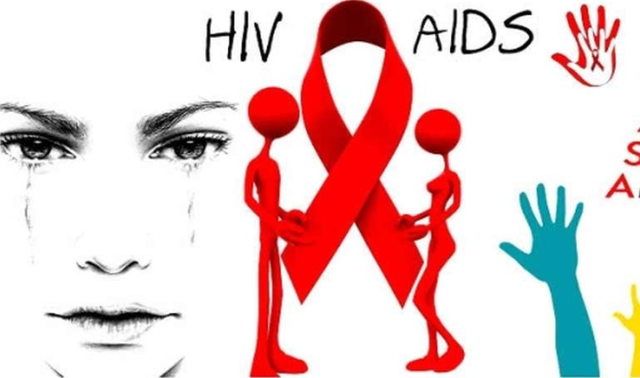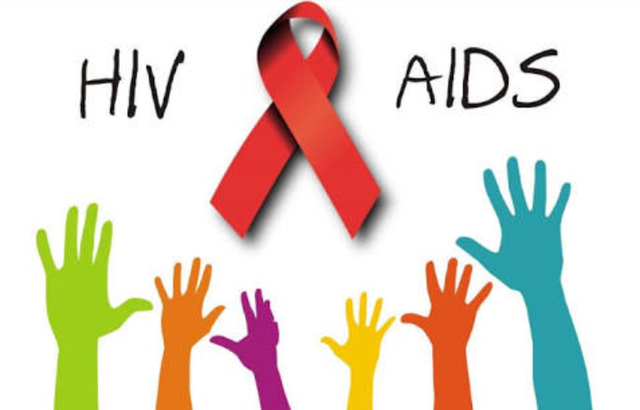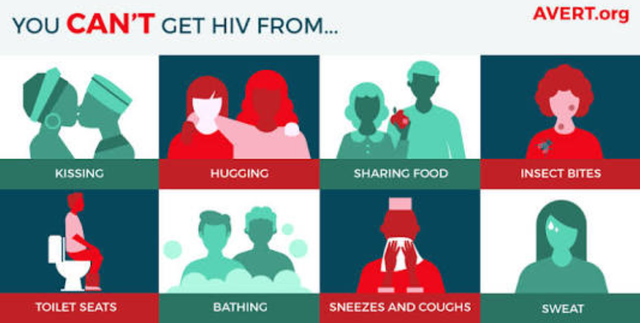HIV and AIDS: symptoms, causes, diagnosis, treatment and prevention


Understanding of HIV and AIDS
HIV (human immunodeficiency virus) is a virus that damages the immune system, by infecting and destroying CD4 cells. The more CD4 cells that are destroyed, the immune system will become weaker, so that it is susceptible to various diseases.
HIV infection that is not immediately treated will develop into a serious condition called AIDS (Acquired Immune Deficiency Syndrome). AIDS is the final stage of HIV infection. At this stage, the body's ability to fight infection has completely disappeared.
Until now there is no cure for HIV and AIDS. However, there are drugs to slow the progression of the disease, and can increase the patient's life expectancy.
Types of HIV
The HIV virus is divided into 2 main types, namely HIV-1 and HIV-2. Each type is divided into several subtypes. In many cases, HIV infection is caused by HIV-1, 90% of which are HIV-1 subtypes M. While HIV-2 is known to affect only a small number of individuals, especially in West Africa.
HIV infection can be caused by more than 1 virus subtype, especially if someone is infected with more than 1 person. This condition is called superinfection. Although this condition only occurs in less than 4% of HIV sufferers, the risk of superinfection is quite high in the first 3 years after infection.
Symptoms of HIV and AIDS
HIV symptoms are divided into several stages. The first stage is the stage of acute infection, and occurs in the first few months after a person is infected with HIV. At this stage, the immune system of an infected person forms antibodies to fight the HIV virus.
In many cases, symptoms at this stage appear 1-2 months after infection. Patients are generally unaware of being infected with HIV. This is because the symptoms that appear are similar to flu symptoms, and can disappear and relapse. Keep in mind, at this stage the amount of virus in the bloodstream is quite high. Therefore, the spread of infection is easier at this stage.
Symptoms of an acute infection stage can be mild to severe, and can last up to several weeks, which include:
-Fever to shiver.
-A rash appears on the skin.
-Gag.
-Pain in the joints and muscles.
-Swollen lymph nodes.
-Headache.
-Stomach ache.
-Sore throat and thrush.
After a few months, HIV infection enters the latent stage. The latent stage infection can last for several years or decades. At this stage, the HIV virus is increasingly developing and damaging the immune system.
Symptoms of HIV infection at latent stages vary. Some sufferers do not feel any symptoms during this stage. However, some other sufferers experience a number of symptoms, such as:
- Weight loss.
- Night sweats.
- Fever.
- Diarrhea.
- Nausea and vomiting.
- Shingles.
- Swollen lymph nodes.
- Headache.
- The body feels weak.
The latent stage infection that is late to handle, will make the HIV virus more developed. This condition makes HIV infection enter the third stage, namely AIDS. When the patient enters this stage, the immune system has been severely damaged, making the patient more susceptible to other infections.
Symptoms of AIDS include:
- Weight loss goes unnoticed.
- Night sweats.
- White spots on the tongue, mouth, genitals, and anus.
- Purple spots on the skin that cannot be lost.
- Fever lasting more than 10 days.
- Chronic diarrhea.
- Nerve disorders, such as difficulty concentrating or loss of memory.
- Fungal infections in the mouth, throat, or vagina.
- Easy bruising or bleeding without cause.
- Irritability and depression.
- Rash or spots on the skin.
- Hard to breathe.
- The body always feels weak.
Complications of HIV and AIDS
HIV infection makes the immune system weakened, so the body is more susceptible to various diseases, including:
- Tuberculosis (TB). TB is a lung infection that often attacks people with HIV, and even a major cause of death in people with AIDS.
- Toxoplasmosis is a parasitic infection that can trigger seizures if it spreads to the brain.
- Cytomegalovirus. Cytomegalovirus is an infection caused by one group of herpes viruses. This infection can cause damage to the eyes, digestive tract, and lungs.
- Candidiasis. Candidiasis is a Candida fungal infection that causes rashes in a number of areas of the body.
- This infection is caused by parasites that live in the digestive system.
- Cryptococcal meningitis. Meningitis is inflammation of the lining of the brain and spine caused by fungi.
- Wasting syndrome. Wasting syndromes are conditions when AIDS sufferers lose 10% of their body weight. This condition is generally accompanied by diarrhea and chronic fever.
- HIV-associated nephropathy (HIVAN). HIVAN is inflammation of the filter in the kidneys. This condition causes interference to remove waste from metabolic waste from the body.
- Neurological disorders. Although AIDS does not infect nerve cells, AIDS sufferers can experience a number of conditions such as depression, irritability, even difficulty walking. One of the most common neurological disorders affecting people with AIDS is dementia.
In addition to a number of the above diseases, there are several types of cancer that can attack people with HIV, including Kaposi's sarcoma and lymphoma. Kaposi's sarcoma is a cancer that can appear along the blood vessels or lymph channels. Whereas lymphoma is a lymph node cancer.
Causes of HIV and AIDS
AIDS is caused by human immunodeficiency virus (HIV). HIV that enters the body will destroy CD4 cells. CD4 cells are part of white blood cells that fight infection. The fewer CD4 cells in the body, the weaker a person's immune system will be.
HIV transmission occurs when blood, sperm, or vaginal fluid from an infected person enters another person's body. This can occur through a variety of ways, including:
- Unprotected Sex. HIV infection can occur through sexual intercourse both vaginal and anal (anal). Although very rare, HIV can also be transmitted through oral sex. However, transmission through oral sex will only occur if there is an open wound in the patient's mouth, such as bleeding gums or canker sores.
- Sharing syringes. Sharing the use of needles with HIV sufferers is one way that can make a person infected with HIV. For example using shared needles when making tattoos, or when using injecting drugs.
- Blood transfusion. HIV transmission can occur when someone receives a blood donor from an HIV patient.
In addition to the various methods above, HIV can also be transmitted from pregnant women to the fetus they contain. The HIV virus can also be transmitted during childbirth, or through breast milk during the breastfeeding process.
Keep in mind, HIV is not spread through skin contact such as shaking hands or cuddling with HIV sufferers. Transmission also does not occur through saliva, except when the patient experiences thrush, the gums bleed, or there are open sores in the mouth.
AIDS Risk Factors
HIV can infect all people of all ages. However, the risk of acquiring HIV is higher in uncircumcised men, whether heterosexual men or male sex men. The risk of contracting HIV is also higher in individuals with a number of factors, including:
- Having sex without wearing a condom. The risk of transmission will be higher through anal sex, and having sex with a partner.
- Suffering from a sexually transmitted infection. Most sexually transmitted infections cause open sores in the sufferer's genitals, thus increasing the risk of contracting HIV.
- Sharing injections. Injecting drug users generally share needles in using drugs.
Diagnosis of HIV and AIDS
To determine whether the patient is infected with HIV, an HIV test must be carried out. Screening is done by taking a patient's blood or urine sample to be examined in the laboratory. The type of screening to detect HIV is:
- Antibody test. This test aims to detect antibodies produced by the body to fight HIV infection. Although accurate, it takes 3-12 weeks for the amount of antibodies in the body to be sufficiently high to be detected during an examination.
- Antigen test. The antigen test aims to detect p24, a protein that is part of the HIV virus. An antigen test can be done 2-6 weeks after the patient is infected.
If screening shows that the patient is infected with HIV (HIV positive), the patient needs to undergo further tests. In addition to ensuring screening results, the following tests can help doctors know the stage of infection, and determine the right treatment method. Just like screening, this test is done by taking a sample of the patient's blood, to be examined in the laboratory. Some of these tests include:
- Calculate CD4 cells. CD4 is a part of white blood cells that are destroyed by HIV. Therefore, the fewer CD4 counts, the greater the likelihood that someone has AIDS. Under normal conditions, CD4 counts are in the range of 500-1400 cells per cubic millimeter of blood. HIV infection develops into AIDS if the CD4 cell count results below 200 cells per cubic millimeter of blood.
- Viral load examination (HIV RNA). Viral load examination aims to calculate RNA, part of the HIV virus that functions to replicate. The amount of RNA is more than 100,000 copies per milliliter of blood, indicating that HIV infection has just occurred or is not handled. While the amount of RNA is below 10,000 copies per milliliter of blood, indicating the development of the virus that is not too fast. However, this condition still causes slow damage to the immune system.
- Resistance (immune) tests for drugs. Some subtypes of HIV are known to be immune to anti-HIV drugs. Through this test, doctors can determine the type of anti-HIV drug that is right for the patient.
Treatment of HIV and AIDS
Although until now there is no cure for HIV, there are types of drugs that can slow down the development of the virus. This type of drug is called antiretroviral (ARV). ARVs work by eliminating the elements that the HIV virus needs to replicate, and prevent the HIV virus from destroying CD4 cells. Several types of ARV drugs, among others:
- Efavirenz
- Etravirine
- Nevirapine
- Lamivudin
- Zidovudin
During taking antiretroviral drugs, the doctor will monitor the number of viruses and CD4 cells to assess the patient's response to treatment. CD4 cell counts will be carried out every 3-6 months. While HIV RNA examination is done from the beginning of treatment, continued every 3-4 months during the treatment period.
Patients must immediately take ARVs once they are diagnosed with HIV, so that the development of the HIV virus can be controlled. Delaying treatment will only make the virus continue to damage the immune system and increase the risk of HIV patients developing AIDS. In addition, it is important for patients to take ARVs according to doctor's instructions. Skipping consumption of drugs will make the HIV virus develop faster and worsen the patient's condition.
If the patient misses the drug consumption schedule, drink it as soon as you remember, and keep following the next schedule. But if the dose is missed enough, talk to your doctor immediately. The doctor can change the prescription or dosage of the drug according to the patient's condition at that time.
HIV patients can also consume more than 1 ARV drug in a day. Therefore, patients need to know the side effects arising from the consumption of these drugs, including:
- Diarrhea.
- Nausea and vomiting.
- Dry mouth.
- Bone fragility.
- High blood sugar levels.
- Abnormal cholesterol levels.
- Damage to muscle tissue (rhabdomyolysis).
- Heart disease.
- Dizzy.
- Headache.
- Hard to sleep.
- The body feels tired.
Prevention of HIV and AIDS
Until now, there is no vaccine that can prevent HIV infection. However, infection can be prevented by the following steps:
- Use a new condom every time you have sex, either sex through the vagina or through the anus. When choosing a lubricating condom, make sure the water-based lubricant is. Avoid condoms with oil-based lubricants, because they can make condoms leak. For oral sex, use non-lubricating condoms.
- Avoid having sex with more than one partner.
- Tell your partner if you are HIV positive, so that your partner has an HIV test.
- Discuss again with your doctor if you are diagnosed positive for HIV during pregnancy, regarding subsequent treatment and planning of labor, to prevent transmission from mother to fetus.
- For men, it is advisable to be circumcised to reduce the risk of HIV infection.
See a doctor immediately if you suspect that you have just been infected with the HIV virus, for example because you have sex with an HIV patient. The doctor can prescribe the drug post-exposure prophylaxis (PEP), for consumption for 28 days. PEP is a combination of 3 antiretroviral drugs, which can prevent the development of HIV infection. Even so, therapy with PEP must start at least 3 days after a viral infection occurs.

Play Safe!
Posted from myAirClinic Healthcare App. Download Android Version from PLAYSTORE!
I ever join your @air-clinic.
To listen to the audio version of this article click on the play image.

Brought to you by @tts. If you find it useful please consider upvoting this reply.
Educating the masses regarding HIV and AIDS is imperative. Even though we have made several breakthroughs over the years regarding HIV, the majority of laymen still have negative perceptions towards people who were living with HIV. Nice article by the way.
This is a very complete article about HIV / AIDS. from prevention, causes, and treatment.
I previously also knew about HIV. but by reading this article I became more knowledgeable about HIV / AIDS. and many people are infected with HIV because many other diseases enter the body. So for HIV sufferers to do is increase their immune system by eating foods that contain antioxidants such as mangosteen.
and a few hours ago, I just posted a way to send via the air-clinic platform) I would be very happy if you came to read it. :)
the reason I made the post was because many people asked me. many of them don't understand. for that reason I made a post.
Nice article. How about the use of HIV test strips to test for HIV?
A very detailed post on HIV/AIDS. I have a plan on writing a series post In Sha Allah
Posted using Partiko Android